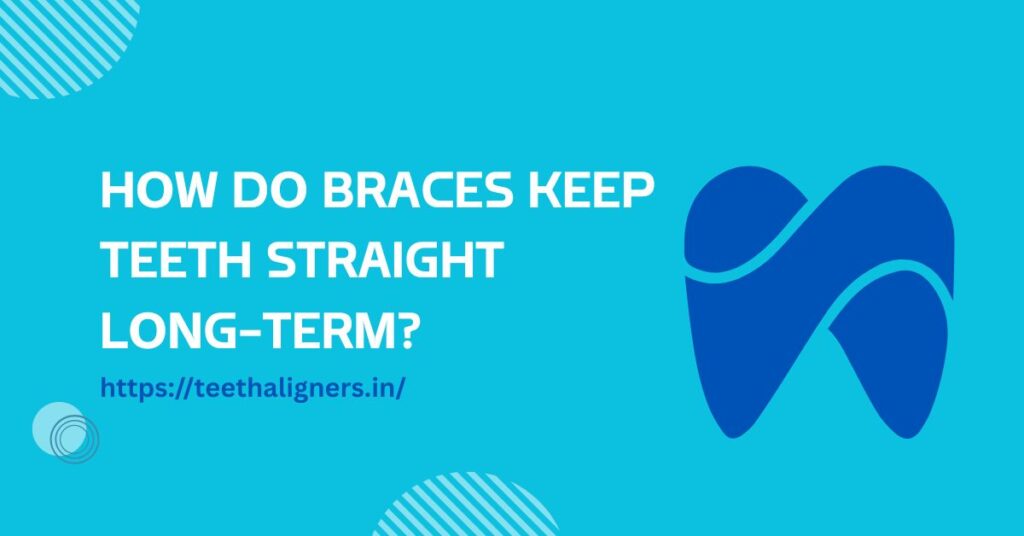Have you ever wondered why some people who had braces years ago still have straight teeth today, while others struggle with shifting smiles? Straight teeth don’t stay in place on their own,they need guidance and support.
The process of keeping teeth aligned long-term is a mix of biology, orthodontic science, and consistent care.This article explains in simple terms how braces guide teeth into place.
What happens inside your mouth during treatment, and why long-term habits make a difference. If you live in Delhi or anywhere else, understanding these steps will help you appreciate the effort behind your lasting smile.
Table of Contents
ToggleThe Basics of Orthodontic Treatment
What Are Braces?
Braces are orthodontic devices that help align crooked or crowded teeth by applying gentle, continuous pressure. They consist of small brackets attached to each tooth, wires that connect those brackets, and elastic bands that add extra support.
Together, they create steady pressure that slowly moves teeth into better positions over time.This movement happens gradually because the mouth is a living system.
Teeth are surrounded by bone and tissue that respond to pressure by reshaping and rebuilding. Without this biological process, orthodontic treatment would not be possible.
In the same way, removable orthodontic aligners also guide teeth into place, but they do so with clear trays that can be taken out when eating or cleaning, offering a more flexible alternative to traditional braces.
Why Straight Teeth Matter
Straight teeth are about much more than appearance. Properly aligned teeth make it easier to chew food evenly, reduce strain on the jaw muscles, and lower the risk of chipped or worn teeth.
Crooked teeth can cause gum issues because they are harder to clean, allowing plaque to build up in tight spaces. Over time, this may lead to gum disease or cavities.
When orthodontists correct misaligned teeth, they improve both function and aesthetics. A balanced bite helps prevent problems like jaw pain, uneven wear, and difficulty in speech. Many patients also feel more confident after treatment, which is an important benefit of having a straight smile.
How Braces Move Teeth During Treatment
The Role of Pressure and Bone Remodeling
When braces apply pressure to teeth, they trigger a natural process called bone remodeling. On one side of a tooth, the bone tissue breaks down, creating space for movement.
At the same time, new bone forms on the opposite side, holding the tooth in its new position. This delicate balance of breaking down and rebuilding allows safe movement without damaging the roots.
Orthodontists adjust the wires every few weeks to keep this process active. Each adjustment creates small amounts of pressure that encourage steady progress. The adjustments may feel tight at first, but they are necessary for controlled movement.
Why the Process Takes Time
Teeth cannot be moved overnight because the bone and tissues around them need time to adapt. Moving too quickly would risk harming the roots or weakening the supporting bone.
That’s why orthodontic treatment often takes months or even years, depending on the complexity of the case.Patience is key, because the slow process ensures safety.
Orthodontists plan the sequence of movements carefully, deciding which teeth should shift first and how the bite will improve step by step. This careful approach leads to long-lasting results.
Long-Term Stability After Braces
Why Teeth Try to Shift Back
Even after successful treatment, teeth have a tendency to drift toward their original positions. This happens because of the fibers in the gums and ligaments that surround the teeth. These fibers act like elastic bands, pulling the teeth back to where they started.
Other factors can also influence relapse, including growth changes in the jaw and everyday habits like chewing or clenching. Without support after treatment, it’s common for some degree of shifting to occur.
The Role of Retainers
Retainers are the key to long-term success. They hold teeth in place while the bone and tissues around them stabilize. Some retainers are removable, while others are fixed behind the teeth. The choice depends on the patient’s needs and the orthodontist’s recommendation.
For most people, wearing retainers is a lifelong habit. In the first months after treatment, retainers are worn full-time. Over time, patients may only need to wear them at night. Skipping retainers is the number one reason for teeth shifting back after orthodontic treatment.
Supporting Habits That Keep Teeth Straight
Good Oral Hygiene
Keeping teeth clean during and after treatment is essential. Plaque and tartar weaken the gums and bone, making teeth more likely to shift. Brushing twice a day, flossing daily, and visiting the dentist regularly are simple steps that protect the stability of your smile.
When orthodontists give hygiene instructions, they are not only preventing cavities but also helping teeth remain stable. Healthy gums and bone create a solid foundation for straight teeth.
Balanced Diet
Eating the right foods also plays a role in keeping teeth straight. Hard or sticky foods can damage retainers or create unnecessary pressure on the teeth. Calcium-rich foods, like milk, yogurt, and leafy greens, support bone health. A strong jawbone helps teeth stay firmly in place.
Sugary snacks should be limited, as they encourage plaque buildup and weaken enamel. A well-balanced diet supports both general health and oral health, making it easier for teeth to remain straight over time.
Regular Dental Visits
Even after treatment ends, regular dental checkups are vital. Dentists can spot early signs of shifting and provide solutions before it becomes a bigger issue. In clinics such as Teeth Aligners in India, patients receive follow-up care to make sure their alignment remains stable.
The Science Behind Long-Term Success
Periodontal Ligaments and Memory
Teeth are supported by small fibers called periodontal ligaments. These ligaments have “memory” and try to pull teeth back to their original positions.
Retainers help retrain these ligaments so they adapt to the new alignment. This process can take months or even years, depending on the patient’s age and bone structure.
Growth and Aging Factors
Younger patients often see more stable results because their bones adapt quickly. However, this does not mean adults cannot maintain alignment. With consistent retainer use, adults also enjoy lasting results.
Aging naturally changes the jaw structure, especially in the lower front teeth, which may become crowded over time. That’s why retainers are recommended for both young and older patients.

Lifestyle Choices That Affect Alignment
Teeth Grinding (Bruxism)
Grinding puts extra pressure on teeth, which can slowly shift them out of place. Night guards or retainers can protect against this damage. Patients who grind their teeth need extra care to preserve their orthodontic results.
Thumb Sucking or Nail Biting
For children, habits like thumb sucking can undo progress by creating pressure against the front teeth. Adults who bite their nails may also put uneven force on certain teeth. Breaking these habits is essential for long-term stability.
Accidents or Trauma
Injuries from sports, falls, or accidents can shift teeth even after treatment. Using a mouthguard during physical activities is a smart way to protect both natural teeth and orthodontic results.
Why Consistency Matters
The Role of Patience
Many people in Delhi and other cities expect quick results, but orthodontics is about steady progress and lifelong maintenance. Braces straighten teeth during treatment, but retainers and healthy habits keep them straight for years afterward.
Long-Term Mindset
Patients who see orthodontic treatment as a lifelong investment are more likely to protect their results. Wearing retainers, maintaining hygiene, and visiting the dentist are small actions that add up to long-term success. Straight teeth require consistent care, even after treatment ends.
Common Myths About Braces and Long-Term Results
Myth 1: Once Teeth Are Straight, They Stay That Way Forever
This is false. Without retainers, teeth can shift back within months. Retainers are essential for maintaining alignment.
Myth 2: Adults Don’t Need Retainers
Adults are just as likely to experience shifting as teenagers. In fact, aging can make adults more prone to crowding, especially in the lower jaw.
Myth 3: Retainers Are Temporary
Many patients believe retainers are only for a short period, but in reality, retainers may be needed for life. Even if worn only at night, they protect the investment made in orthodontic treatment.
Real-Life Example of Long-Term Care
One patient who wore braces as a teenager shared how she lost her retainer and stopped using it. Within a year, her front teeth began to crowd again, forcing her to restart treatment with aligners.
Another patient, however, faithfully wore her retainer as instructed. Fifteen years later, she still has perfectly straight teeth. These two stories highlight how daily habits, even something as simple as wearing a retainer at night, determine whether orthodontic results last a few years or a lifetime.
Conclusion
Braces create beautiful, healthy smiles, but the real success lies in keeping those results for life. Long-term alignment depends on wearing retainers, practicing good hygiene.
Visiting the dentist regularly, and avoiding harmful habits. With small but consistent efforts, patients can protect the investment they made in orthodontic treatment.
At Teeth Aligners in India, patients receive complete guidance on both treatment and aftercare, helping them maintain their smiles for years to come. With the right support and daily habits, your teeth can stay straight and healthy long after treatment ends.

